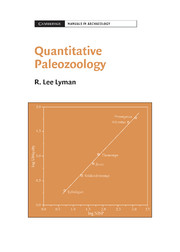Book contents
- Frontmatter
- Contents
- List of figures
- List of tables
- Preface
- 1 Tallying and Counting: Fundamentals
- 2 Estimating Taxonomic Abundances: NISP and MNI
- 3 Estimating Taxonomic Abundances: Other Methods
- 4 Sampling, Recovery, and Sample Size
- 5 Measuring the Taxonomic Structure and Composition (“Diversity”) of Faunas
- 6 Skeletal Completeness, Frequencies of Skeletal Parts, and Fragmentation
- 7 Tallying for Taphonomy: Weathering, Burning, Corrosion, and Butchering
- 8 Final Thoughts
- Glossary
- References
- Index
2 - Estimating Taxonomic Abundances: NISP and MNI
Published online by Cambridge University Press: 05 June 2012
- Frontmatter
- Contents
- List of figures
- List of tables
- Preface
- 1 Tallying and Counting: Fundamentals
- 2 Estimating Taxonomic Abundances: NISP and MNI
- 3 Estimating Taxonomic Abundances: Other Methods
- 4 Sampling, Recovery, and Sample Size
- 5 Measuring the Taxonomic Structure and Composition (“Diversity”) of Faunas
- 6 Skeletal Completeness, Frequencies of Skeletal Parts, and Fragmentation
- 7 Tallying for Taphonomy: Weathering, Burning, Corrosion, and Butchering
- 8 Final Thoughts
- Glossary
- References
- Index
Summary
As paleontologists, Chester Stock and Hildegard Howard were interested in the abundance of the mammals that had walked the landscape and birds that had flown in the air above the landscape at the time the faunal remains from Rancho La Brea were deposited (Chapter 1). Zooarchaeologists (known as archaeozoologists in Europe), on the other hand, are typically interested in which taxa provided the most economic resources and which taxa provided little in the way of economic resources. Thus, as zooarchaeologist Dexter Perkins (1973:369) noted, “the primary objective of faunal analysis of material from an archaeological site [or from a paleontological site] is to establish the relative frequency of each species.” This target variable sought by paleontologists and zooarchaeologists concerns taxonomic abundances. What are the frequencies of the taxa in a collection?
In any given collection of paleozoological remains, one might wish to know if carnivores are less abundant than herbivores, just as they normally are on the landscape. Given what he knew about ecological trophic structure – that herbivores should outnumber carnivores – imagine Stock's surprise to learn that the typically observed food pyramid or ecological trophic structure was upside down. The mammalian remains from Rancho La Brea represented more carnivores than herbivores − for a reason that many paleontologists thought was a taphonomic reason – because scavenging carnivores got “bogged down” or mired in the sticky tar seeping from the ground and failed to escape.
- Type
- Chapter
- Information
- Quantitative Paleozoology , pp. 21 - 82Publisher: Cambridge University PressPrint publication year: 2008
- 2
- Cited by



